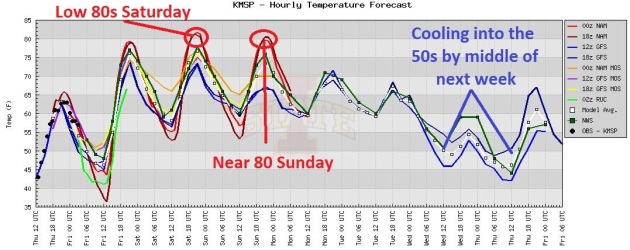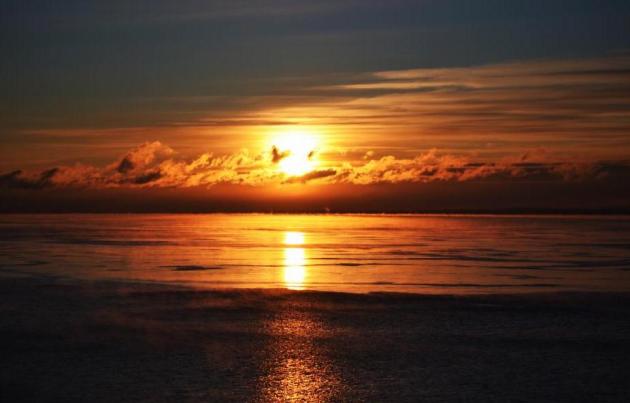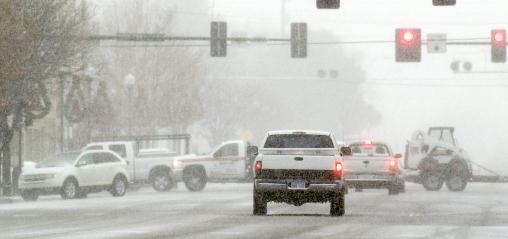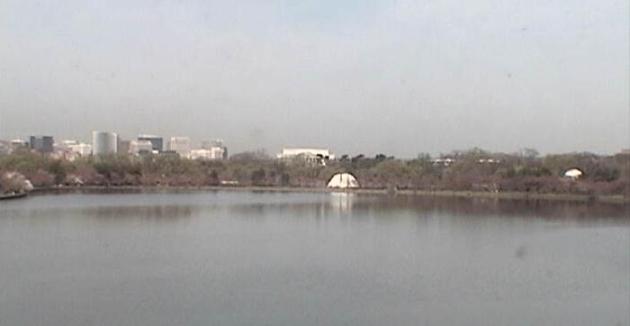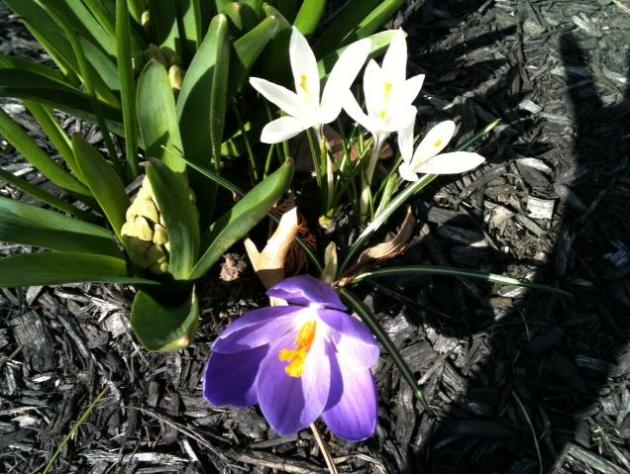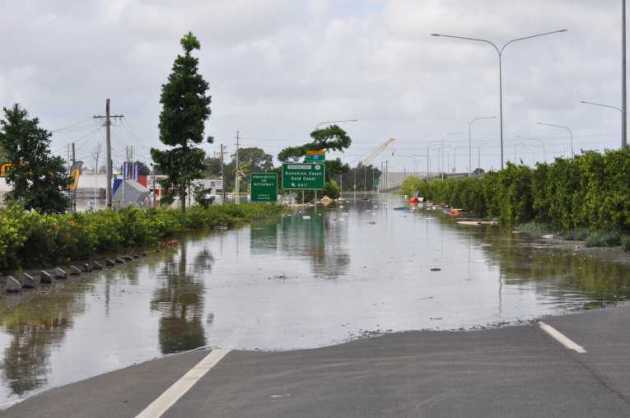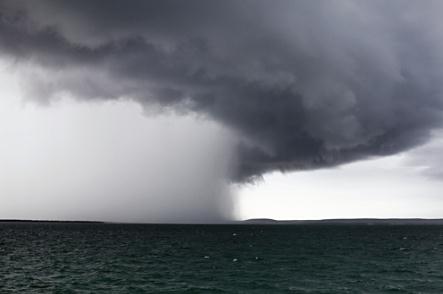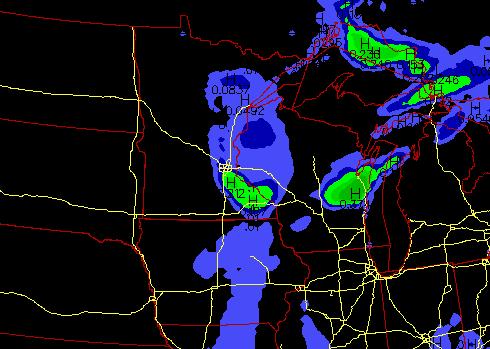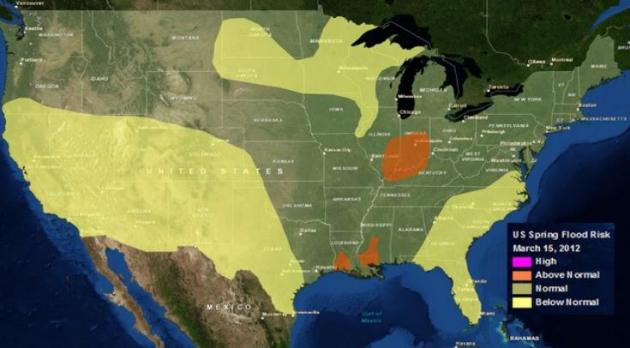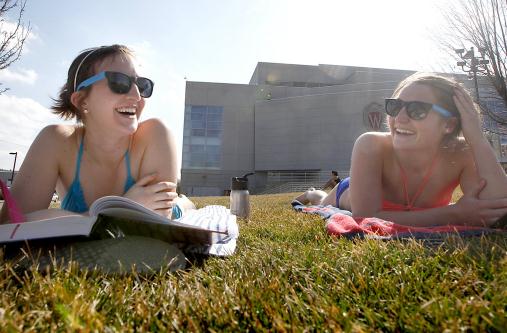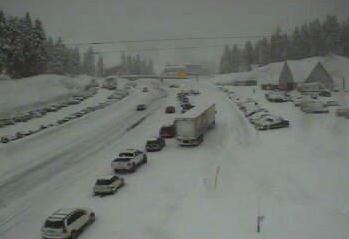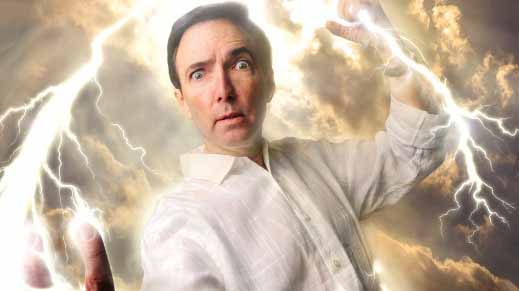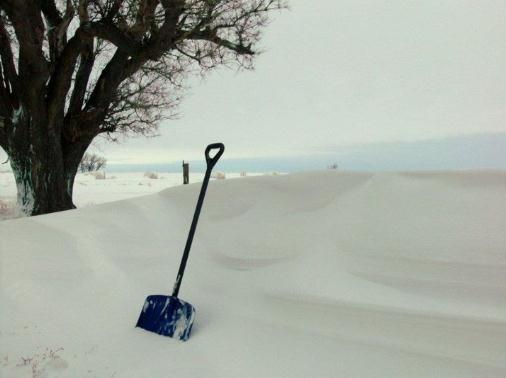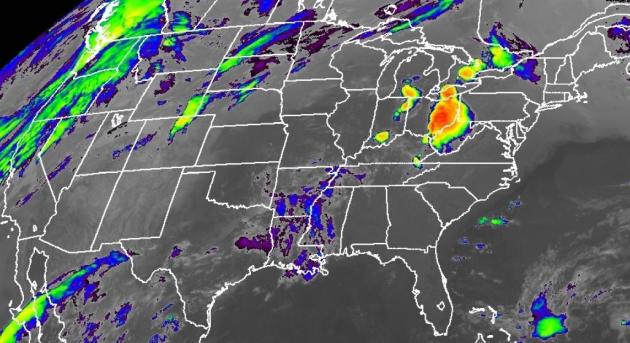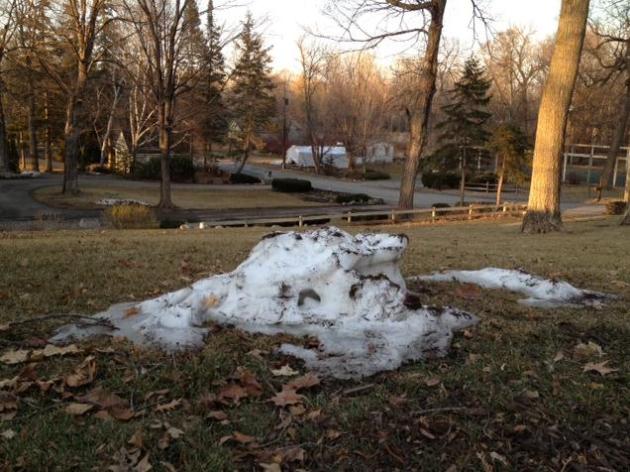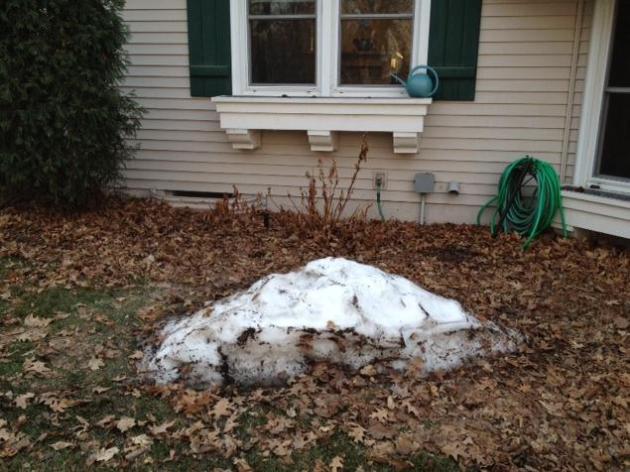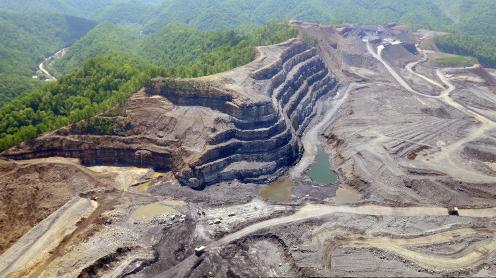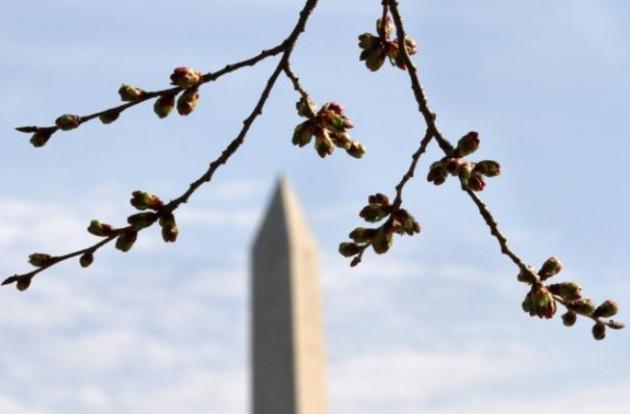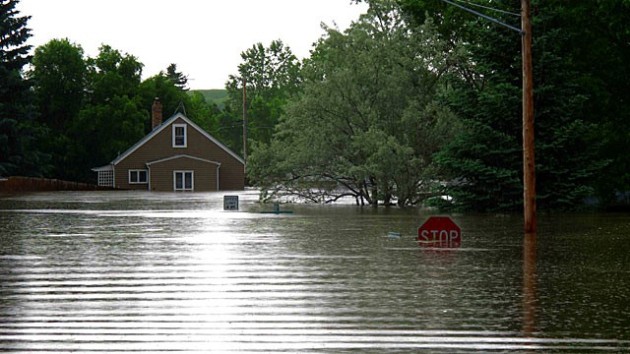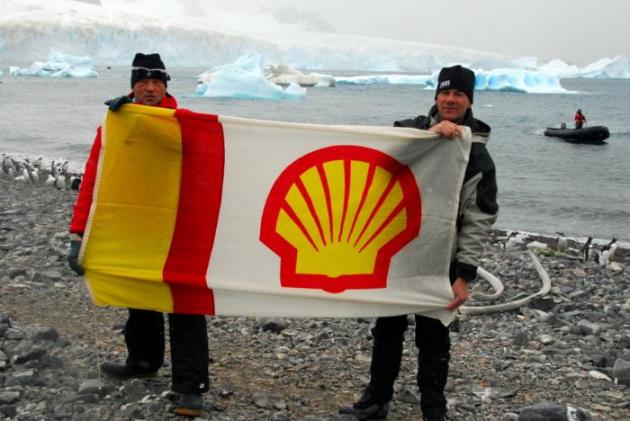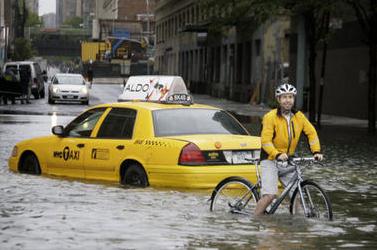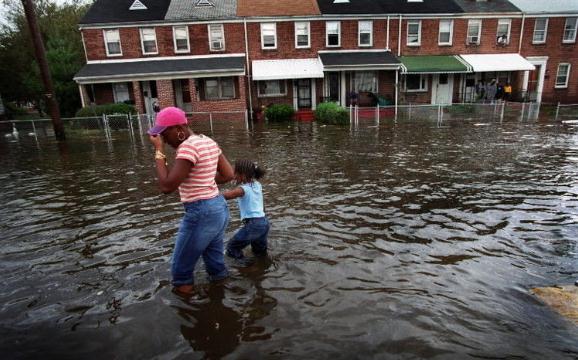80 Saturday & Sunday in the Twin Cities? If the mercury reaches 80 it'll be the earliest 80 in modern-day history. The previous record for earliest 80 at KMSP? March 23, 1910 (83 F.)
September 26. Today the sun will be as high in the sky as it was on September 26. It is possible to get a tan (or burn) in mid-March. If you're sprawling outside in the warm, record-breaking sun this weekend, don't forget the sunscreen.
Dazed And Amazed. Notice how every successive computer run keeps bumping temperatures higher and higher? It's been the trend all winter. As you get closer to the actual "event" the temperature is +5 to +15 F. higher than it was at the beginning of the week. All the models are now hinting at 80+ on Saturday, near 80 Sunday, followed by a cooling trend by the latter half of next week.
December 21, 2011
March 16, 2012
Super-Charged Daylight. By my rough calculations (higher math) we've picked up
3 hours and 10 minutes of daylight since December 21. That extra energy (and optimism?) you're feeling may have a little something to do with that.
Twin Cities Record Highs Paul's Forecast
71 F. today (1930)
78
76 F. Saturday (1894)
82
71 F. Sunday (1921)
80
72 F. Monday (1910)
72
66 F. Tuesday (1938)
69
* all these records will be broken. The only question is Tuesday. If it rains hard enough (?) daytime temperatures may stay just below 66. It'll be a close call.

"Spring shows what God can do with a drab and dirty world." - Virgil A. Kraft
8" snow. Statistically, that's how much additional snow should fall between mid-March and the end of April. Place your bets. Source:
Minnesota Climatology Working Group.
9 subzero nights this past winter at Marquette, Michigan - fewest ever recorded. Details below.
4. Lowest spring river flood threat in 4 years, nationwide, according to NOAA.
Catching Our Breath. This (terrific) photo sums it up: straight from winter to summer. Do not pass "go". No spring for you! "
More unseasonably warm weather beckoned people outside on a perfect spring afternoon Wednesday, March 14, 2012 in Minneapolis, Minn. With piles of snow still melting in the parking lot nearby, Bob Olson of Crystal visited with Gary Dodge of St. Louis Park, who was looking for coins near Lake Calhoun with a metal detector Wednesday afternoon. The weather: "It's a fluke," said Dodge. "We'll get paid back. We're from Minnesota," said Olson." Photo: Jeff Wheeler, Star Tribune.
First T-Storms Of 2012? The latest 00z NAM run prints out lifted indices of -6 to -9 (very unstable) with a forecast cape value of 1200 - 3300. The atmosphere may be "capped" (too much warm, dry air aloft for convection to get started), but the model is printing out .29" of rain late Saturday and Saturday night. I suspect a few T-storms will bubble up along this vigorous hot-front. It just keeps getting stranger and stranger...
Downside To All This Warm, Dry Weather. No improvement in our drought - 99.21% of Minnesota is abnormally dry, nearly 96% of the Gopher State is in a moderate drought, 24% in a severe drought (driest conditions south of Willmar and Shakopee. Only a small portion of extreme southeastern Minnesota, near Harmony and Winona, is drought-free.
80 F. at Rockford, Illinois, the earliest 80-degree day on record.
The United States Of Weather Records. This map pretty much sums it up. 2600 weather records in just the last week from coast to coast. 1,029 record highs, 618 record warm nighttime lows, 675 24-hour rainfall records. I'm getting a nosebleed just trying to keep up. Thanks to NOAA and
Ham Weather (full disclosure: one of my 4 weather-related companies) we can break out the records on an interactive map:
| Total Records: | 2600 |
| Rainfall: | 675 |
| Snowfall: | 68 |
| High Temp: | 1029 |
| Low Temp: | 60 |
| Low Max Temp: | 150 |
| High Min Temp: | 618 |
Cherry-Blossom-Cam. Check out the ripening cherry blossoms in Washington D.C. - courtesy of
America's National Park Service.
Shorts And T-Shirts. 80s...in mid-March...from Iowa and northern Illinois east to Washington D.C. "
People enjoy the warm weather near the Washington Monument in Washington, Thursday, March 15, 2012. (AP Photo/Susan Walsh)."
"It might sound surprising to a skeptical public, but culture was always a vital part of Goldman Sachs’s success. It revolved around teamwork, integrity, a spirit of humility, and always doing right by our clients. The culture was the secret sauce that made this place great and allowed us to earn our clients’ trust for 143 years. It wasn’t just about making money; this alone will not sustain a firm for so long. It had something to do with pride and belief in the organization." - excerpt of the (flaming) goodbye letter from the Goldman Sachs executive. Story from Yahoo Finance below. Graphic above from
Bloomberg BusinessWeek.
An Early May. Joan Kruhoeffer sent in this photo of crocus in full bloom from Lititz, Pennsylvania. The calendar is whispering March, but the atmosphere overhead is shouting May.
"
The studies find up to 32 percent more coastal real estate vulnerable to a 1 meter rise in sea level, while the population exposed to rising water goes up by 87 percent." - from a story at The Christian Science Monitor below.
"
Measurements have shown that the number of heavy precipitation events has increased by more than 30 percent since 1900 in the United States—and the problem will likely grow worse in the coming years, leaving more and more Americans vulnerable to the immediate and lingering health impacts of flood events."- excerpt from a story from The Union Of Concerned Scientists, details below.
Saturday Evening T-storms? The models keep migrating warm-frontal T-storms farther north/west with each run. The latest guidance hints at a few T-storms late Saturday and Saturday night. Warm fronts tend to be most active at night. With a vigorous warm frontal boundary situated nearby there may be enough convergence, low-level moisture and instability for a few boomers - first of 2012.
Lowest Spring Flood Threat In 4 Years. Finally, some good news out of those hard-working, storm-crazy professionals at NOAA. Little snow to begin with, coupled with a gradual melt-down, a rapid loss of ground frost (meaning water can soak into the topsoil, not run off into streams and rivers) and lack of heavy rain (or snow) all equates into potentially the tamest spring flood season in 4 years. More from
NOAA: "An above normal risk for spring flooding exists over the Lower Ohio Valley and parts of the Central Gulf Coast in Southern Louisiana and Mississippi. Above-normal precipitation this winter in parts of the Ohio River Valley has caused high soil moisture and above-normal river levels. The forecast through April calls for above-normal precipitation in the Ohio River Valley which could lead to flooding.
For the first time in 4 years, the Northern Plains are not expecting major to record snowmelt flooding. Most of the Upper Mississippi and Middle to Upper Missouri River Basins have a below normal risk of flooding. The nation's farthest northern basins of North Dakota and Montana including the Red River of the North, Souris River and the Missouri headwater have a normal risk of flooding, and will not be significantly impacted by snowpack this year."
Mad Weather In "Mad Town". No need to evacuate to Florida or Arizona this March, in fact the weather is considerably better in Minnesota and Wisconsin than it is in Arizona, where a series of Pacific storms are sparking heavy rain, high winds and unusually cool weather. Poor babies. Sunbathing, in Madison, Wisconsin...in mid-March? Welcome to a parallel universe, where summer in the Upper Midwest lasts 6 months or more. At least this year. "
University of Wisconsin-Madison seniors Haley Africano, left, and Elyse Kleifgen enjoy summer-like temperatures while sunning themselves on the lawn of the of the Kohl Center in Madison, Wisconsin Wednesday, March 14, 2012. (AP Photo/Wisconsin State Journal, John Hart)."
Stevens Pass, Washington State. Check out the
WSDOT webcam showing US2 at Stevens Pass - one big, snowy parking lot. Yes, winter is alive and well west of the Rockies.
Fewest Subzero Nights On Record At Marquette, Michigan. Only 9? Hey, we only had 3 here in the Twin Cities this past winter. Like Marquette, the average number of subzero nights at MSP is 30/winter. Right. I'm no NASA rocket scientist but notice how the top 5 warmest (with the fewest subzero nights) winters came since 1994-95. Oh, that has to be a coincidence. "
With the warm Winter of 2011-2012 winding down, here a few interesting statistics on subzero days recorded at the Marquette National Weather Service office located in Negaunee Township. For these statistics, the time period considered as "winter" is November through April since those are the months when subzero days can occur. The average number of subzero days is 30." Data:
Marquette National Weather Service office.
Could It Happen Again? Frank Carlin Says Yes. Here's a story about New Jersey's vulnerability to storm surges from
Ocean City Gazette: "
OCEAN CITY — Meteorologist Frank Carlin was Ocean City’s new emergency dispatcher when the infamous 1962 storm hit the Jersey Shore. Fifty years later, he’s still on the job. At 75, he’s the weather coordinator for Somers Point. Recently presented a plaque by Gov. Chris Christie for five decades of service, he still gets excited about an impending storm. Carlin says given atmospheric conditions the past few months and an unusual winter, we could be in for a wild spring and summer as the hurricane season heats up. “I’m worried,” he said. “I’ve been tracking storms a long time, tracking hurricanes for the National Weather Service. It’s a big concern. You can’t control nature, you just have to watch out for it."
"Ask Paul." Weather-related Q&A:
"Paul, I have read much on tipping points, particularly studies of the ice sheet cores. While meteorologists often say that weather is not climate is not weather, couldn't a tipping point change that...that, in fact, it could be a switch? I don't mean to scare people but something is off. There is so low soil moisture in some parts of the state that planting could be rough...not good. Boy, I pray we don't have the Summer of '88 times 2!"
- Peter Tharaldson, Best Buy - via Facebook
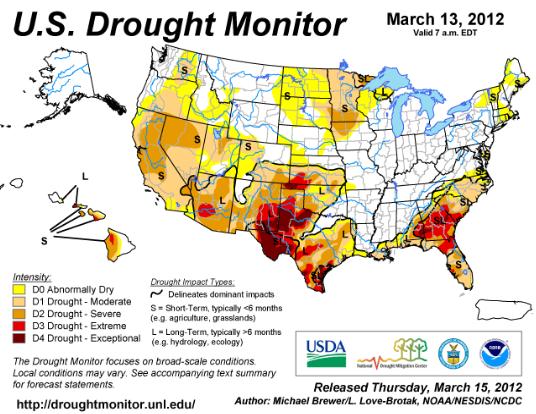
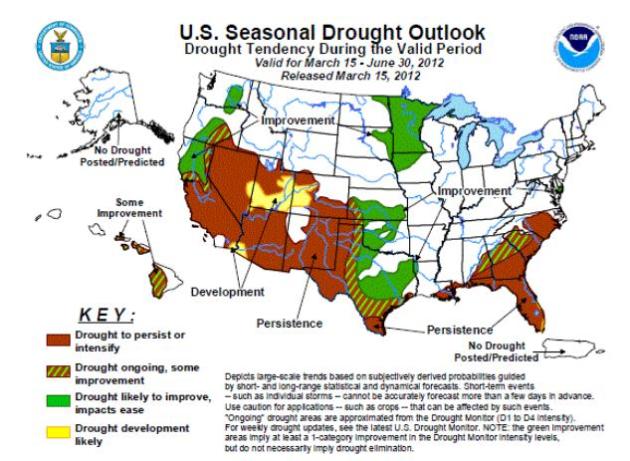
Peter - I share your concerns. 1988 had 44 days above 90 in the metro. The entire state is currently in a drought, roughly a quarter of Minnesota in a severe drought. Soil moisture is very low, lake water levels are down 2-3 feet on many lakes. That old adage "when in a drought, don't predict rain" rings true. I keep waiting for a pattern shift, but I don't see one anytime soon. Meteorologists talk about "persistence", which basically means go with the flow, don't rock the boat - don't fight the trends. Although I don't see a rerun of 1988 (God help us) I do believe much of Minnesota will experience more drought through much of 2012. When it ends, the severity, and implications - I don't pretend to know. As far as tipping points go, all I can say is if you warm up the atmosphere, even by a few degrees, you dramatically increase the potential for more extreme events (more water vapor aloft), and you greatly increase the potential for record warm events - which is exactly what we're seeing this year. Many climatologists are concerned that we are, in fact, nearing a tipping point. I don't pretend to know. All I know is that the past 2 years have probably been the most severe in U.S. history, coming at a time when temperatures continue to warm, worldwide. It may be the greatest coincidence ever, but (connecting the dots) I suspect a link of some sort.
* the maps above are from
NOAA's Drought Portal at
drought.gov. NOAA is predicting "improving conditions" for Minnesota in the coming weeks - I hope they're right, but right now I see no (short-term) evidence of a return to wetter than normal conditions.
_________________________________________________________________________
"
After last year’s brutal snowfalls, I put snow tires on my car for the first time in my 20 years in MN. Of course, this year I barely needed them. What are the predictions for spring 2012 snowfalls? Do you think it’s safe to take the snow tires off?"
Thanks,
Carolyn Cochran
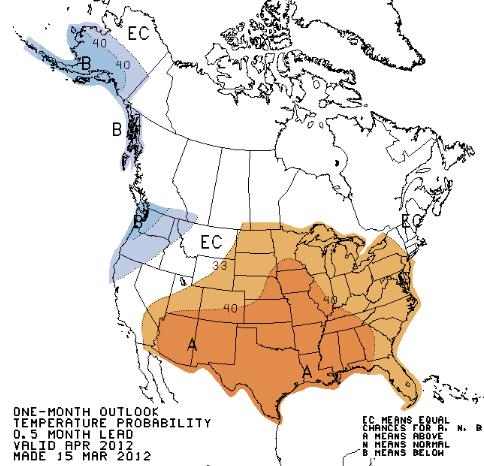
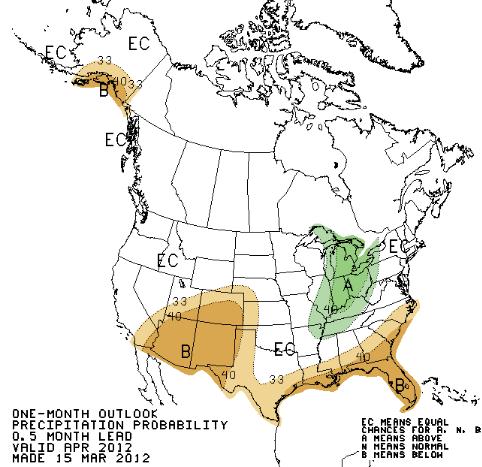
Carolyn - it's a good, (loaded) question. For what it's worth, I just took off my snow tires yesterday, so my confidence level is fairly high that we won't see a significant number of additional slush-storms. Statistically, we should see an additional 8" of slushy snow between mid-March and early May. Ugh. But it's pretty obvious that this is no ordinary spring pattern. The CPC (Climate Prediction Center) outlook for April (above) shows a bias toward continued warmth east of the Rockies, the best chance of rain over the Great Lakes and Ohio Valley. My hunch: we may see a few minor "slush events", possibly even another inch or two, but the beauty (if I can use that word) of an April snow? It's usually gone within a few hours. With this overwhelming warm bias we're seeing on the maps I think the odds of a typical/average late March and April snowfall pattern are greatly reduced. We're not quite out of the woods, but I can see clearing ahead! BTW - you can check the April Outlook from CPC, the Climate Prediction Center
here.
Dear Paul
"I have a prediction that I'm sure will come true: Even though we're enjoying June-like weather in March, wondering if it could be climate change or just weather-weirdness, and basking in glorious sunshine, I predict that most folks will be as grumpy as a bear roused too-soon from hibernation when we get to June and the weather sours with blustery temps, cloudy skies, and day upon day of drizzle……
Or how about this anecdote – we were in Duluth some years ago over the Fourth of July and spotted a pedestrian near Canal Park in a down parka with the snorkel hood fully extended!
Minnesota weather, you gotta love it!
Thanks for your great daily weather reports."
Dave Fernelius
Crystal, MN
Thanks Dave - appreciate the kind words. I spend entirely too much time on these daily blogs, but I find them vaguely therapeutic, a chance to gradually collect stories, links, photos and maps that catch my eye during the course of an 18 hour day. I liked your anecdote, and you may be right (about the other shoe/boot dropping). I can't believe it'll stay these balmy - continuously - into August. That just makes no sense. At some point we will probably see a relapse (or 2), a spell of 40s and 50s, maybe even a little slush. But any snow in early April usually melts within a few hours - the sun is too high in the sky for it to linger, like it does in January. Or used to linger, back in the good 'ol days for Minnesota snow lovers. As for June: place your bets. I suspect a long, hot (dry) summer is shaping up. I hope drought isn't the big story. If we do see a sudden pattern shift (ie more big, sloppy storms) it will also mean a heightened risk of severe storms and tornadoes. So there's your weather menu for 2012: drought...or scattered tornadoes. Can I take your order?

. Favorite weather-related web sites:
1).
Ag Overview From USDA. Although there aren't a lot of details - it's a good place to start get a few agricultural details and how weather is impacting farmers from coast to coast.
2).
TwisterData.com. If you're tracking storms, first check NOAA's SPC site, then turn to twisterdata.com. They have a clean layout, rapid model updates, and special fields, like "EHI" (above), the Energy Helicity Index, a measure of both wind shear and instability in one parameter. The map above is valid this evening at 7 pm, showing a heightened risk of strong storms as close as Des Moines. That said, the atmosphere may be "capped", too much warm, dry air aloft for convection - a better chance of isolated T-showers south/east of Madison and the Quad Cities this weekend.
3).
NOAA "Fire Detect". This site tracks the latest brushfires and forest fires around the USA. I'm concerned about a growing risk of brushfires across the Upper Midwest, the result of a deepening drought, warm sun, gusty winds and low humidity levels. Until we green up, or see a few major storms, the threat will continue to escalate.
River Of Ice. Check out two amazing photos from
neatorama.com. I've never seen anything like this: "
Brr! You're looking at what happens in Russia when winter snow starts to melt and then flash froze in a cold snap into a river of ice. That would make one very fun (and surely fatal) slide down! Via Buzzfeed."
Why I Am Leaving Goldman Sachs. If you haven't read the good-bye note from the Goldman Sachs trader, you should. It's pretty extraordinary. Here's an excerpt from
Yahoo Finance: "
It might sound surprising to a skeptical public, but culture was always a vital part of Goldman Sachs’s success. It revolved around teamwork, integrity, a spirit of humility, and always doing right by our clients. The culture was the secret sauce that made this place great and allowed us to earn our clients’ trust for 143 years. It wasn’t just about making money; this alone will not sustain a firm for so long. It had something to do with pride and belief in the organization. I am sad to say that I look around today and see virtually no trace of the culture that made me love working for this firm for many years." Photo: Wikipedia.
Brown Recluse Spider Causes Fear After It Nearly Blinds Texas Student. As if we didn't all have enough to worry about.
Pinoy Point has the story: "
The Brown Recluse Spider is now causing arachnophobia to some people after the news about how it nearly blinds a girl from Texas surfaced. The brown recluse spider is now considered more dangerous than the highly-dreaded black widow because of the way its venom affects the human victim and not just how poisonous it is. A bite from the brown recluse spider causes necrosis, a premature death of cells in living tissue (treated via surgery), and this is why people should avoid this spider at all cost." Brown recluse spider photo: graftedno1
The New Apple TV Will Finish What The Mac Started: Killing Off Discs. The story from
seekingalpha.com: "
I remember watching the HD DVD vs. Blu-ray wars closely a few years back. I wanted one to win so I could go out and buy a next generation movie player. But the battle went on and on, and by the time Blu-ray won, I had set my sights on a new frontier: digital distribution. I never did get that Blu-ray player. And now I’m quite certain I never will. The new 1080p Apple TV (AAPL) is here."
NASA's New Glasses Let's Pilots See Through The Fog.
Yahoo News has the fascinating details: "
The world's deadliest aviation disaster took place on a foggy airport runway rather than in the air. That's why NASA is offering augmented reality glasses that would allow commercial airline pilots to see a virtual version of runways in even the worst weather conditions. Such glasses represent a portable head-worn display that shows critical flight information such as airspeed, altitude and orientation floating in front of one eye at all times. The NASA display would also track pilots' heads so that an updated virtual outline of an airport's runways and towers always appears wherever they look — allowing them to keep their attention on what's happening outside rather than staring at a chart or tablet."
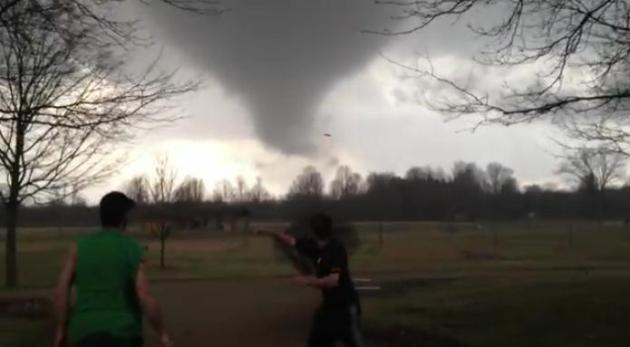 Disc-Golfing In A Tornado?
Disc-Golfing In A Tornado? Now I've officially seen everything. Darwin must be turning over in his grave. I shouldn't have to say this out loud, but
don't try this at home. The ridiculous
YouTube clip is here. "
How far can you throw in a head wind like this? Tornado that Hit Dexter, Michigan n we were caught dead center as it circled us."
At Least They Have A McSense Of Humor. Thanks to Tricia Frostad for sending this one along - always looking for stuff that makes me laugh.

"
Dreams are answers to questions we haven't yet figured out how to ask." - X-Files
"March Is The New May"
Be afraid. I took my snow tires off yesterday. "Paul, is that it for winter - are we in the clear?" I'm hearing that a lot. Truth: statistically we SHOULD see another 8" of slush between now and the end of April. Any other year I'd say "a few more sloppy snows are inevitable." But all bets are off this year. 2012: the year we went right from winter to summer. Spring optional.
In just the last week the USA has seen well over 1,000 high temperature records, 675 records for warm nighttime lows - earliest 80s ever recorded for some towns in Wisconsin and Iowa; records for early ice-outs. I am Beyond Baffled.
Yesterday's "cool front" is history. A southerly surge pushes the mercury into the upper 70s today. If we do hit 80 tomorrow & Sunday in the Twin Cities metro it would be the earliest 80 on record at MSP.
1910 brought 5 days above 70 in March. If we hit 70 on Tuesday (possible) we'll break that record too. I suspect it'll be too warm aloft (a "capped atmosphere") for weekend T-showers; the best chance of rain next Tuesday.
We cool off a bit late next week (you may need a light jacket), but no frost is in sight - 60s and a few 70s return the last week of March. It is still March, right?
"
In America today you can murder land for private profit. You can leave the corpse for all to see, and nobody calls the cops." - Paul Brooks, "The Pursuit of Wilderness" (1971). Photo above:
wvgazette.com.
Here's
an interesting story; not sure I totally agree with the conclusions, but in the spirt of debate, here is an excerpt: "AccuWeather.com reports the extreme weather, including a near-record number of tornadoes, in 2011 forced the debate of the impact of climate change on severe weather to resurface. While there has been research into the subject, there are still many unknowns. Is a warming climate causing more active severe weather already? Before examining how climate change may affect severe weather in the future, it is important to analyze whether the frequency or strength of severe weather has changed already with warming temperatures."
Could Cherry Blossoms One Day Be Blooming In Winter? I sure hope not - because if that day comes, we'll all be in a heap of trouble. A warmer Minnesota sounds great (on one level), but the implications of shorter, warmer winters isn't good: more drought, more infrequent (but severe) storms, more pests, year-round allergies - it's a long list.
The Washington Post has more: "
Washington’s cherry blossoms are busting out early this year, with buds popping so fast that a government work crew this week watched them unfurl on one tree in a single day. The U.S. National Park Service had predicted an early bloom for the centennial year of the hallowed trees. But it has moved up the forecast twice, with temperatures in the 80s and more of the same expected." Photo credit: The Washington Post.
 DC's Cherry Blossoms As Climate Change Canary.
DC's Cherry Blossoms As Climate Change Canary. The story from
Huffington Post: "
Amid all the screaming signs about Global Warming's increasingly serious impact on the world around us and on human civilizations future prospects, the 'luxury' symbolic canaries in the coal mine always create mixed emotions. Global Warming's threat to skiing (and declining viable Winter Olympics locations), and to wine making and bourbon and beer and chocolate and maple syrup and ... production, etc ... Yes, these are tangible examples of how global warming impacts the world around us and impacts us. On the other hand, compared to increasing natural disasters, devastating storms and droughts threatening vulnerable populations and disruptions to global agricultural production systems, these are "luxury" items whose (in and of themselves) disruption does not represent a fundamental threat to human civilization (no matter how important the maple syrup for your pancakes or that bourbon for warming up after a day on the slopes). Yes, as we all know in our Madison Avenue dominated world, symbols matter and cherished symbols even more so."
Climate Change And Your Health: The Hidden Health Risks Of Flooding In A Warming World. Here's a story from
The Union Of Concerned Scientists: "
Heavy and prolonged precipitation can lead to a major flooding event and a dangerous cascade of health risks that can linger for months or even years. In the days following a flood, drivers can drown as they attempt to navigate submerged roadways. Sewage systems can back up. Water sources may become contaminated. Even after the waters recede, the health risks continue as mold proliferates inside wet and damaged structures and flood victims struggle with the emotional toll of the disaster. Temperatures in the United States have already risen more than two degrees Fahrenheit (2°F) over the past 50 years, largely because of heat-trapping emissions, and are expected to keep rising throughout the next few decades and likely much longer. Rising temperatures have likely contributed to an increase in extreme rainfall events. As Earth's climate warms, the air is able to hold more water vapor, allowing for more intense downpours that can lead to flooding."
Speeding Up Climate Change Through Time-Lapse Photography. The story from
petapixel.com: "
The Extreme Ice Survey (EIS) is a multi-year project by National Geographic photographer James Balog that aims to make show climate change in action through time-lapse imagery of glaciers. Balog has 27 Nikon D200 DSLRs pointed at 18 glaciers around the world snapping 8,000 photographs each year while powered by solar panels. His custom-designed rigs — created through months of trial and error — also include heavy duty tripods, waterproof cases, and wind-proof anchors. He has also created a documentary film about his project titled Chasing Ice."
Doctors Warn Climate Change May Lead To Spike In Asthma Cases. The story from
U.S. News And World Report: "
A group of lung doctors warned Thursday that climate change will likely lead to an increase in the rate and severity of a variety of respiratory diseases. "We felt as though the medical community was not understanding how climate change might impact patients and their health," says Kent Pinkerton, director of the Center for Health & the Environment at the University of California-Davis. Pinkerton says the warning came out of a meeting of top climate change scientists and lung doctors that discussed the potential impacts of global warming on patient health."
Shell Sued For "Causing Climate Change."
Reuters has the story: "
Oil giant Royal Dutch Shell Plc said it was sued for causing climate change but that, like some other global warming cases taken against energy companies by environmentalists, the cases were dismissed. The Anglo-Dutch group said in its annual report, published on Thursday, that, "together with other energy companies" it was subject to climate change litigation taken by parties it did not name. "We believe these lawsuits are without merit and are not material to Shell," the world's second-largest non-government controlled oil company by market value added. Scientists believe carbon dioxide emissions from burning fossil fuels such as oil and gas are a major cause of global warming." Photo:
blogs.shell.com.
Will Your City Be Underwater? There's A Map For That. More on the recent studies predicting accelerated sea level rise and higher vulnerability for America's coastlines from
PBS: "
Will your city or county be flooded by 2020? By 2050? Now there's a map for that. As many as 3.7 million U.S. residents in 2,150 coastal areas could be battered by damaging floods caused by global warming-induced storm surges, according to a new report published Wednesday in the journal Environment Research Letters. Sea levels could rise as much as 19 inches by 2050, according to what the report calls "mid-range projections." The team used data from the U.S. Geological Survey to map all areas along the continental U.S. coastline containing homes that lie within one to 10 feet from the water level at high tide."
Sea Level Studies: America's Coastlines More Vulnerable Than Previously Thought. Here's a slightly different angle to the same headline, this time from The Christian Science Monitor: "Cities and hamlets along
America's popular coastlines are more vulnerable to rising sea levels than previously estimated, according to a pair of new studies. The studies find up to 32 percent more coastal real estate vulnerable to a 1 meter rise in sea level, while the population exposed to rising water goes up by 87 percent. The numbers vary markedly by region, with south
Florida, southern
Louisiana, and the Carolinas topping the list of states with the most land to lose. Populations would be most heavily affected in Florida, Louisiana,
California,
New York, and
New Jersey, the studies find."
Photo credit above: "
Flooding in New York City last summer from Hurricane Irene. Scientists are predicting a possible 1-meter rise in sea level, which may impact coastal cities. Peter Morgan/AP/File."
Study Finds Warming Doubles Maryland's Flooding Risk. A local, Maryland angle, from
The Baltimore Sun: "
New research indicates that rising sea level from climate change will roughly double the risks of storm-related flooding in coastal communities in Maryland and nationwide. Scientists with Climate Central, an independent nonprofit journalism and research organization, have produced maps showing how even small increases in sea level rise are likely to push storm surges onto shore. They've also published their findings in peer-reviewed journals. In Maryland, past and future global warming nearly doubles the estimated odds of “century” or worse floods occurring within the next 18 years, they say — meaning floods so high they would historically be expected just once per century. Elsewhere along the nation's coastline, the risks triple."
Photo credit above: "
Flooding in Baltimore's Turner's Station after Tropical Storm Isabel, 2003 (Glenn Fawcett)."
Texas Plan For Rising Sea Levels: Wait 'Till God Tells Us To Build An Ark. The story from
The Dallas Observer: "
Want to give yourself a good case of the climate-change willies? Go to climatecentral.org, click on their report on sea level rise and look for Texas. We could be in for it worse than California, depending on how you measure. When national media talk about sea-level rises, they tend to focus on New York, L.A. and New Orleans, not anything in Texas, because Texas, most people think, is pretty much all sand, sagebrush and Rick Perry. But you know what? If we're not careful one day it could be true, depending on how long he lives."
